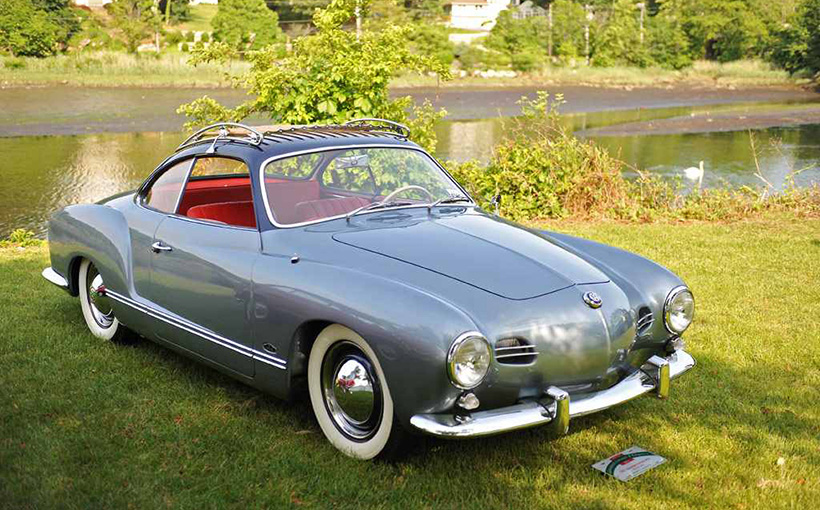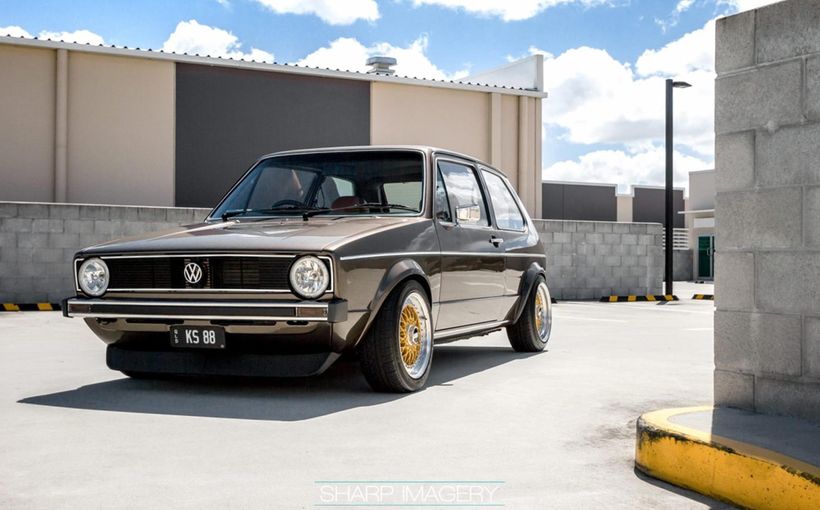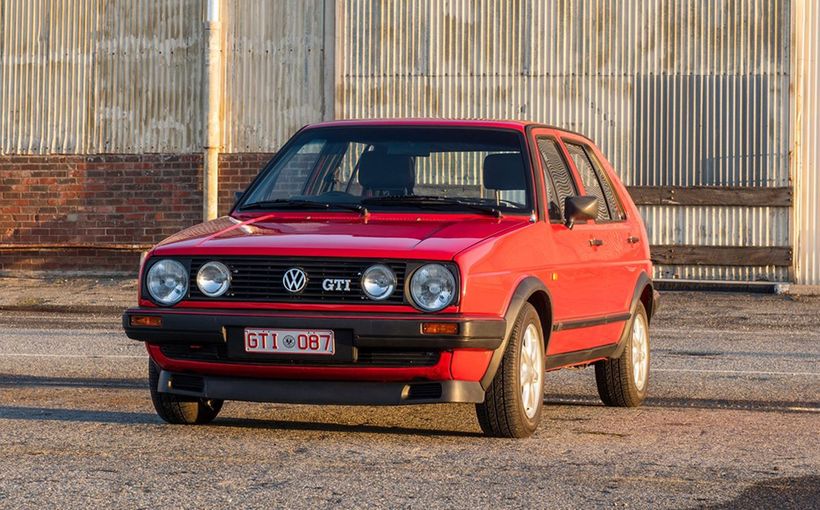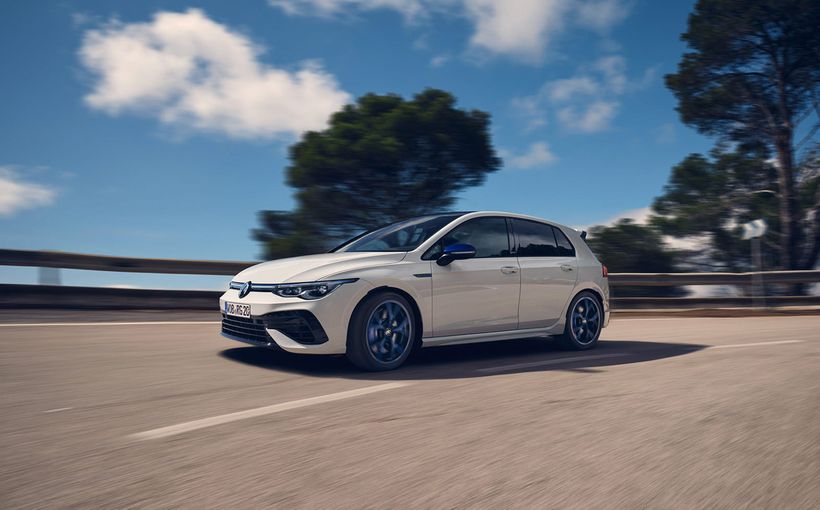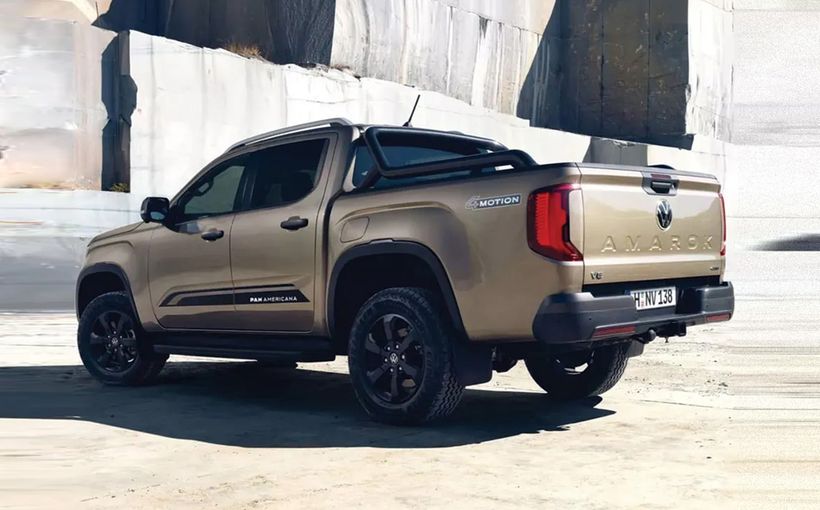1960-68 Volkswagen Karmann-Ghia: Every Coupe Came with a Bug
By
JoeKenwright -
15 September 2014

The original Karmann-Ghia style as launched in 1955 was quite different in detail compared to the model launched in Australia at the close of 1959. Note the lower profile headlights and more pronounced front vents. The myriad compound curves evident here required each panel to be made up from several smaller panels welded together which involved extensive hand-finishing by German body-builder Karmann. (Photo from
fromconceptcarz.com)
The late 1959 local arrival of the Karmann-Ghia marked the end of an era. It was the last accessible model ever which allowed the buyer to specify a bespoke custom body on an otherwise ordinary car. Although 387,795 were produced between 1955 and 1974 globally to satisfy huge US demand, they were all subject to much higher levels of hand assembly at Karmann’s Osnabruck facility than any rival coupe in this price range. The Karmann-Ghia was a coach-built phenomenon on a scale that has never been matched since.
When the Karmann-Ghia was released in 1955, only the most exclusive prestige manufacturers were offering buyers the choice of different body styles completed outside the factory. Of the sports cars, Ferrari and Maserati were the most prolific with Alfa Romeo occasionally commissioning a build for special purposes. There were a handful of coach-built Porsches based on the 356 but only by special arrangement. Lancia offered a range of styles by different body builders on certain models while Aston Martin would later form an alliance with Zagato.
Beyond that it was left to Rolls Royce and Bentley to offer a wide choice of bodies and coachworks. In this context, what the Karmann-Ghia was offering was a bargain even if it added at least 30 per cent to the price of the standard Beetle on which it was based.

Virgil Exner’s amazing Chrysler Ghia D’Elegance coupe shown here is often listed as the inspiration for the VW Karmann-Ghia. It is true there are several carryover design cues but there are just as many differences. The D’Elegance coupe was intended for limited production, a process cut short by the Korean war, so Ghia applying its resources to develop a VW coupe was encouraged. (Photo from
carstyling.ru)
Although other manufacturers would attempt to match the coupe style and performance of the Karmann-Ghia, nothing came close to matching its coachbuilt aura at this price, something that the model carried for almost 20 years without compromise. The relatively tiny changes over that period are testimony to how advanced the styling was in 1955 and how well Volkswagen and Karmann managed the necessary updates along the way.
The Karmann-Ghia as a product of the VW Beetle’s platform chassis also marked the end of an era globally when a free-standing chassis could be cloaked in a separate body that was not integral to the car’s structure. It was named after Karmann, the builder of the special body, and Ghia, who designed it.
For an indicator of the uniqueness of the original Beetle-based Type 14 Karmann-Ghia phenomenon, look no further than the fact that it even outlived its replacement. In 1961, Volkswagen and Karmann launched a new Type 34 Karmann-Ghia coupe based on the more powerful VW 1500 Type 3 platform. Even if it was an interesting design, it didn’t sell as well and was gone by 1969 after just 42,500 were built, by which point the original was undergoing a second wind.

This 1951 Studebaker is probably the missing link in the Karmann-Ghia styling. It was completed by the Raymond Loewy studios while Virgil Exner was in charge of the Studebaker work. The resemblance around the front is close enough to suggest that Ghia started by combining a Studebaker front with the Chrysler D’Elegance rear, as both were setting the global styling agenda at the time. (Photo from
eastohiocoolcars.com)
Was it Italian or American?
Ghia’s most conspicuous client in the early 1950s was Virgil Exner who, by 1953, had become Chrysler’s styling director. By 1950, he had already headed-up Raymond Loewy’s Studebaker design contract so there was no shortage of Exner-influenced Studebakers already on the roads before his landmark Chrysler Ghia studies.
The timing of the Chrysler Ghia D’Elegance, a swoopy Exner-designed coupe based on his Chrysler K310, was a stunner for 1953. It pioneered the soft oval coupe side window profile flanked by slender pillars leading into a gently sloping tail with small vertical wings or fins defining each corner. It also featured a distinctive rear quarter panel line that swept over the rear wheels and had its origins in a horizontal pressing that was neither a sill line or waist line. There was nothing like it at the time.
A variation of these rear quarters flanking a gently sloping rear lid would still be appearing on Valiants in the early 1960s. It’s hard to argue against the widely-held premise that Ghia took Exner’s ideas for this coupe and applied them to the special Volkswagen body. However, that doesn’t explain the dramatic difference at the front where there is no resemblance whatsoever.

Apart from the non-standard wide wheels, this was how the Karmann-Ghia looked when it was launched in Australia in 1959-60 with the raised headlights and revised front vents. Because it was a full import, it carried a 50 per cent price premium over the local Beetle compared to the 30 percent premium in other markets. Yet a steady trickle of Australian buyers meant it was often seen on Australian roads as it could be driven anywhere that a Beetle could go, a big selling point in Australia at that time for a car that looked so exotic.
The accepted history of the Karmann-Ghia coupe is that Ghia had been trying for some time to convince Volkswagen to use its Turin studio as design consultants. Various Ghia proposals to improve the Beetle were ignored, not surprising given that Volkswagen needed to leave the Beetle alone which they did. It didn’t require a design studio to increase the glass area, about the only major styling tweak made to the Beetle before the Superbug arrived in the 1970s.
German coachbuilder Karmann also kept getting rejection slips for its proposals to build special Volkswagens and out of frustration proposed a collaboration with Ghia. The two Ghia principals, Mario Boano and Luigi Segre are the personalities most often mentioned as the fathers of the Karmann-Ghia.
The real catalyst was Boano’s son who had purchased a new Beetle in France and drove it back to Italy. The body was stripped-off and the Ghia workers constructed a new coupe body. The result was good enough for Ghia to present it to Volkswagen towards the end of 1953, about the same time as the Ghia D’Elegance coupe surfaced. It was not a bad context when the Chrysler show car was top of mind in the industry.
Volkswagen pushed the button on the project. Karmann was given the go ahead to manufacture the entire vehicle ready for insertion into the VW distribution channels after the running chassis had been delivered by Volkswagen to the Karmann factory. It helped that both facilities were in Germany.
It came at an important time for Ghia as proposed limited production for the Chrysler Ghia D’Elegance had to be suspended well short of intended volumes after vital steel supplies were rationed for the Korean war.

The Karmann-Ghia’s success led to this Renault Floride (it was conceived in Florida hence the name) rival based on the Dauphine sedan. It was styled by Virgil Exner’s son under Ghia supervision while he was in Europe on military service. The Floride in original 1-litre Dauphine spec was tediously slow but later Caravelle models powered by the R8’s 1108cc engine were better. Renault famously took action against MG for copying this design for the MGB yet the Floride itself reflected latest Ferrari designs minus their grilles. (Photo from
classicandperformancecar.com)
There were some last minute pre-production styling tweaks to the Karmann-Ghia that many believe verify there was no connection with the Exner Chryslers. This includes the Karmann-Ghia’s blind rear-engined nose styling and the addition of twin slots that broke up the expanse of paint at the front.
A quick look at the front of the 1950 Studebaker nose styling suggests that Boano and Segre didn’t want to stray too far from the Exner connection. Fill in the centre spinner of the 1950 Studebaker front with rounded sheet metal and the slots shared on both noses appear remarkably similar. The three pontoon shape (a protruding centre section flanked by similar rounded sections on each side) of the Studebaker front section is also a very distinctive feature of the Karmann-Ghia that was never changed.

This early shot of Karmann’s German assembly line highlights the complexity of the body and the detailing that went into its assembly. The fastidious meeting of shut lines on so many levels and gradients really set this car apart even for the 1950s, yet it was all sitting on a Beetle platform. It was a work of art and crossed into sculpture. (Photo from
ranwhenparked.net)
The Beetle Connection
The viability of the Karmann-Ghia project depended on minimal changes being made to the running Beetle chassis sent from Wolfsburg. In this way, Karmann’s role of adding a different body was not a lot different from later beach buggy manufacturers even if the all steel Karmann-Ghia body was closer to a work of art for many buyers.
The platform chassis’ side rails were extended for a body that was now four inches/101.6mm wider and a front anti-roll bar was added to at least create the illusion of slightly sportier handling. This front anti-roll bar was added to later Beetles anyway.
The steering column was dropped to a sportier angle and the gear lever shortened in deference to the lower driving position. Although the new body was 7in/178mm lower, the roofline and lowered seating position still left adequate headroom for 1950s occupants and their hats, an important consideration for the times.
The Karmann-Ghia body was also 3in/76mm longer which in combination with the reduction in height left the new coupe with beautiful proportions despite the Beetle’s stumpy 94.5in/2400mm wheelbase. To place this in a more modern context, the Karmann-Ghia’s wheelbase was similar to the first Mazda RX-7/Porsche 924 and seemed to define a sweet spot for small sporty coupes of that era.
Because the Karmann Ghia’s extra width was entirely inside the doors and not wasted on the Beetle’s running boards, the increase in front cabin width was closer to 6in/152mm. This allowed extra sprawling room and generous seats, although describing them as buckets would be stretching the definition.
The rakish windscreen also allowed a proper dash which had a clock added to the standard VW instruments, which in the first cars was a speedo only. The Karmann-Ghia gained a fuel gauge ahead of other Beetle models in 1958. Like the Beetle, the rear seat could be folded into a luggage platform and there was marginally more room in the front boot.

The Karmann-Ghia’s closest rival in Australia in quality and looks was the Borgward Isabella TS coupe, a model highly prized by its Australian owners. The wife of Borgward’s owner insisted on a coupe to match the Karmann-Ghia but it wasn’t cheap as it was another 50 per cent dearer than the Karmann-Ghia. (Photo from
commons.wikimedia.org)
The frameless door glass and heavily curved screens front and rear were state of the art on the new model’s 1955 launch. However, the extra body size and increase in glass area boosted weight by 150lbs/67.5kg.
This dictated a re-think in torsion bar rates and shocks. The lower rear deck height also prompted a side-mounted air cleaner. The wider engine bay left room to spare for after market engine upgrades but Volkswagen kept mechanical specs strictly in line with the current Beetle.
The extra weight also meant that Karmann-Ghia weight distribution was marginally better than the Beetle and the centre of gravity was much lower. Although this created the sensation of a better handling Volkswagen, its actual limits were about the same with the driver facing the same evil swing axle camber changes under duress and the potential of flipping the car on its lid if pushed too far.

At the lower end of the market, the modular construction of the Triumph Herald and Michelotti styling allowed local assembler AMI to field several competitive locally assembled Triumph Herald coupes at a full 30-40 per cent less than the Karmann-Ghia. They were generally quicker and more fun to drive but the lower body was shared with the sedan. (Photo from
motorbase.com)
The reduction in air-resistance meant that acceleration was about the same. Under the right conditions, the Karmann-Ghia might have been able to find an extra 10-15km/h top speed as the Beetle’s overdrive 4th gear was always limited by the Beetle’s bluff shape, not revs. The Karmann-Ghia’s sleeker front would allow the standard 36bhp/27kW engine to creep to a higher speed given the time and space.
Because the Karmann-Ghia lost the Beetle’s bolt-on panels, a big collision was always a concern as each panel with its multiple compound curves was hand-stitched from a series of smaller panels then carefully welded and pounded into shape. Apart from missing out on VW’s full immersion paint process, the bespoke body was vulnerable to rust forming along these weld seams.
If there was an upside to Volkswagen maintaining a direct connection between the Karmann-Ghia and the current Beetle, it meant that the never ending list of improvements added to the Beetle would find their way into the Karmann-Ghia. This made a big difference in markets like Australia where the Beetle would fall behind German upgrades.

Skoda also went down the Triumph Herald route by combining the lower body of its pedestrian sedans with a coupe or convertible roofline. Like the Herald, this Felicia was reasonably attractive with similar swing axle rear suspension and was much cheaper than the Karmann-Ghia. It had a steady but small following in Australia. (photo from
espolarte.com)
Just after the model was introduced to the US market in 1956, the demand generated two year waiting lists. By 1958, a rear defroster vent was ducted to the rear window. In August 1959, the body was re-profiled with higher headlights and a different slot design on the front panels. The earlier style had two fine bars covering the slot, the later style had a single trim piece that integrated three fine bars with the surround. The tail light design and profile was also changed at this time.
A dished steering wheel, push-button door handles, windscreen washers and self-cancelling indicators were amongst the many improvements that came with this body change.
This new style, in combination with a new convertible version in 1958, boosted global demand again and left no room for right hand drive production. Early UK and Australian cars were converted by their respective local operations until the close of 1959.

A Karmann-Ghia as delivered in Australia except this one has the amber indicators of European models. Volkswagen did not switch to amber indicators locally until 1968. Local cars tended to be presented plain and simple with standard hubcaps, clear front indicators and pastel colours often combined with a white roof. (Photo from
drive.com.au)
Key markers then included the new 40bhp/30kW engine for 1961 which came with taller gearing and an all-synchromesh close-ratio gear box. There was a brake upgrade in 1965 and the engine became a 1300 in 1966 with a boost in power to 50bhp/37.3kW.
For 1966, the German range switched to slotted wheels with flat hubcaps, ball joint front suspension, column dipswitch and round button door handles. Trim and seating underwent further improvements.
For 1967, the 1500 engine was fitted with a boost in power to 53bhp/39.5kW and a noticeable increase in torque for much more relaxed driving. The electrics were switched to 12 volts, there were new headlights, wider rear swing axles and front disc brakes, changes that did not apply to Australian Beetles until 1968.

The real achievement of Karmann and Volkswagen was giving the Karmann-Ghia a second lease of life 13 years after release as the first Federal rules threatened to corrupt its purity. This was about as cluttered as it was allowed to get, no mean feat when others cars were destroyed during this period. Later wheels, hubcaps and suspension gave this one a more stable look on the road, not long after the model was withdrawn from Australia in 1968. (Photo from
bid123sold.com)
US regulations demanded major changes after 1968 with round side markers on the front guards and head restraints the most obvious. The Karmann-Ghia was then progressively changed to meet further US regulations including new wraparound front indicators, the girder-style bumpers as fitted to the Beetle and Type 3 and a redesigned tail with Type 3 tail lights. Although the 1600 engine was specified in 1970 with an increase in power to 57bhp/42.5kW and then 60bhp/45kW in 1971, the Superbug’s front MacPherson struts were never fitted to the Karmann Ghia.
In the meantime, the VW-Porsche 914 had already partly taken over the Type 34 Karmann-Ghia’s role. VW’s switch to the sporty Scirocco version of the Golf while dropping the Beetle’s platform chassis, then forced Karmann to swap over to Scirocco body production by 1974.

The second generation Karmann-Ghia was based on the VW Type 3 1500 platform in 1961. It didn’t win the immediate acceptance of the original as market conditions had changed but it was a striking and interesting shape as well as a much better car. It was later imported into Australia in small batches by local Volkswagen distributors where it found eager buyers despite the hefty price. (Photo from
Wikimedia.commons)
The Other Karmann-Ghia
The Type 34 Karmann-Ghia based on the VW 1500 Type 3 and launched in 1961 was not a total failure. Its 42,500 sales for such a bespoke and expensive vehicle before production ended in June 1969 were healthy. Its biggest problem was that it arrived with an additional price premium just as a range of much sexier-looking Hardtops based on US compact models were appearing, then followed by the Mustang.
Its styling and pricing generated expectations well above a special-bodied version of a budget model like the Beetle. Although its 1500 engine seemed significantly larger than a Beetle’s, it couldn’t really deliver a major performance boost in the Type 34 body.
It was easy to criticize the styling in its attempts to look more modern. The long tail and the Type 3’s suitcase engine allowed a sleeker rear profile that had elements of more exotic Italian coupes. The front was a distinctive evolution of the Beetle-based Karmann-Ghia with extra lights. Although the eyebrows of the Type 34 design were criticized, this was a popular styling cue at the time as it reflected Chevrolet’s crisp styling of the Corvair.

There can be little doubt that Chevrolet designers had the Karmann-Ghia in their mind’s eye when defining the landmark 1965 Chevrolet Corvair Monza. With the sting of a flat six and a proper double-jointed independent rear suspension in the tail, it was both a stunner to look at and a nice car to drive. It was the final blow for any plans to field the premium Type 34 Karmann-Ghia as a serious US entry. (Photo from
harwellmotors.com)
And that context explains why it struggled and was never seriously marketed in the US. It was too close to a Corvair coupe and vastly underpowered by comparison. The arrival of Chevrolet’s benchmark second generation Corvair in 1965 was the death knell for any aspirational VW-based model as its styling was almost flawless. VW could keep the Beetle-based Karmann-Ghia well out of the Corvair Monza coupe’s way on price but the Type 34 was a different matter.
Yet it was about this time that the Type 34 maintained a steady acceptance in European markets with a small following in Australia that started with a small batch of imports late in 1964. Based on the Type 3 1500S with that car’s twin-carburettors and higher compression ratio, it wasn’t able to be tested after it displayed the usual range of 1500S tuning problems on poor local fuel.

The rear view of the Type 3 Karmann-Ghia elicited images of many exotic Italian coupes as the Type 3’s suitcase engine allowed a much sleeker, flatter rear deck that gave no clues to it being rear-engined in profile. (Photo from
Wikimedia.commons)
The Type 34 was still an important image builder for Volkswagen in Australia where its inflated imported price was no worse than applied to the Mustang and other imports that were making life tough for it in other markets.
Although this second Karmann-Ghia remains a distinctive and desirable car in the Australian context, its biggest rivals were the cut price premium versions of VW’s own
Type 3 sedans and fastbacks with their extra performance and massive price cuts driven by high local content.

The Karmann-Ghia even survived later US bumpers and Type 3 tail lights looking almost as sharp as it did in 1955, 19 years later. It eventually had to make way for the Golf-based Scirocco coupe styled by Giugiaro, built by Karmann in 1974. (Photo from
photogallery.classiccars.com)
Local Type 14 Karmann-Ghia History
The local history of the Karmann-Ghia was very much tied to what Volkswagen Australia was doing with the Type 3. Australians were not so much attracted to the Karmann-Ghia’s styling as much as the opportunity it represented to buy all the Beetle virtues in a package that didn’t look like a Beetle.
Although the Beetle was popular in Australia, there was an equally strong group of buyers who hated the look of it and resented being forced to buy a small car in 1959 that was older than the first Holden. The
inability for Volkswagen Australia to pass on vital German upgrades and address this factor had made local Volkswagen manufacture unviable by 1966 before it had to be abandoned in 1967.
Already, there had been several high quality local attempts including the Sydney-based Ascort to produce a similar vehicle to the Karmann-Ghia based on the Beetle to meet that exact requirement. The late 1959 arrival of the revamped Karmann-Ghia placed these local attempts on notice and they virtually became redundant overnight. Because these first imports were LHD and had to be converted, just 13 were sold in 1959.

The brilliant Sydney-based Ascort was a casualty of the Karmann-Ghia. Beautifully made with a fibreglass body and a choice of hot VW engines, the Ascort won enormous accolades but there was no point continuing as the factory Karmann-Ghia had the credibility and the Ghia pedigree in its favour.
There was a run on them in 1960 with a healthy 264 sold, despite tough local market conditions. The Beetle was at its height in popularity and the Karmann-Ghia’s strengths on our poor roads far outweighed any lack of performance and dicey swing axle handling. That trend continued into 1961 with 284 sold, the height of local Karmann-Ghia popularity.
However, the instant slump in 1962 sales can be traced to the announcement of the imminent arrival of the Type 3 VW 1500. This car was the Volkswagen you could own with exactly the right margin of extra luggage space, extra performance and 1960s looks.
The Type 3 after all was an amalgam of Karmann-Ghia styling ideas with extra passenger space and ease of access while maintaining an exclusive two door semi-coupe appearance that distanced it from other four cylinder family cars. German parts shortages and local tooling delayed a local VW 1500 from reaching Australia in 1962 yet the wide coverage of its imminent arrival pegged Karmann-Ghia sales back to just 97 in 1962.
This dropped further to 81 as the first local Type 3 examples found 2444 new buyers in 1963. Massive price cuts boosted 1964 Type 3 sales to 3443 explaining why only 28 Karmann-Ghias found a home that year.

The mortal enemy of the Type 14 Karmann-Ghia in Australia was this car. More refined, much faster and better mannered at high speed over rough Australian roads, the VW 1500S/Twin S Type 3 cost only two thirds the price of a Karmann-Ghia and did everything better while looking almost as good. (Photo from
forum-auto.com)
In 1965, there were 31 sales but that number dropped again to just 5 in 1966 as new fastback versions of the Type 3 became the affordable and preferred sporty Volkswagen coupe. By 1967, Karmann-Ghia sales had stopped and then just 2 examples trickled out in 1968, its final year. This was also the year that vastly improved current German specification Beetles and Type 3 examples were offered to Australians for the first time in almost a decade.
Another factor in the ebb and flow of local Karmann-Ghia sales was its price relative to local Beetles. In 1960, a Beetle Deluxe cost $1942 versus $3196 for the Karmann-Ghia. That 30 per cent price premium in other markets was boosted to 50 per cent in Australia as it was the locally assembled Beetle versus the fully imported Karmann-Ghia. By 1964, a much better Beetle with higher local content had dropped to $1798 while the Karmann-Ghia price propped at $3100. The Type 3 1500 sold for only $2198 in 1964 while even the special 1500S twin-carburettor version still cost only $2358.

This is the car that ultimately replaced the Type 3 Karmann-Ghia in most markets. VW-Porsche got this one right as the mid-engined 914 sports car powered by a VW transporter engine in Type 3 suitcase format defied comparison with anything else available at the time and still left room for the original Karmann-Ghia to do its own thing for another five years. (Photo from
themotoringjournal.com)
In hindsight, the key role achieved by the Australian Karmann-Ghia deliveries was to be the pump primer for the arrival of the Type 3 Volkswagen at a time when the Beetle was starting to look a little too familiar. The Karmann-Ghia not only added extra cachet to the Beetle on which it was based as it entered full local manufacture, it then went on to validate the classy but unassuming styling of the factory’s Type 3 models, at which point it became redundant.



















